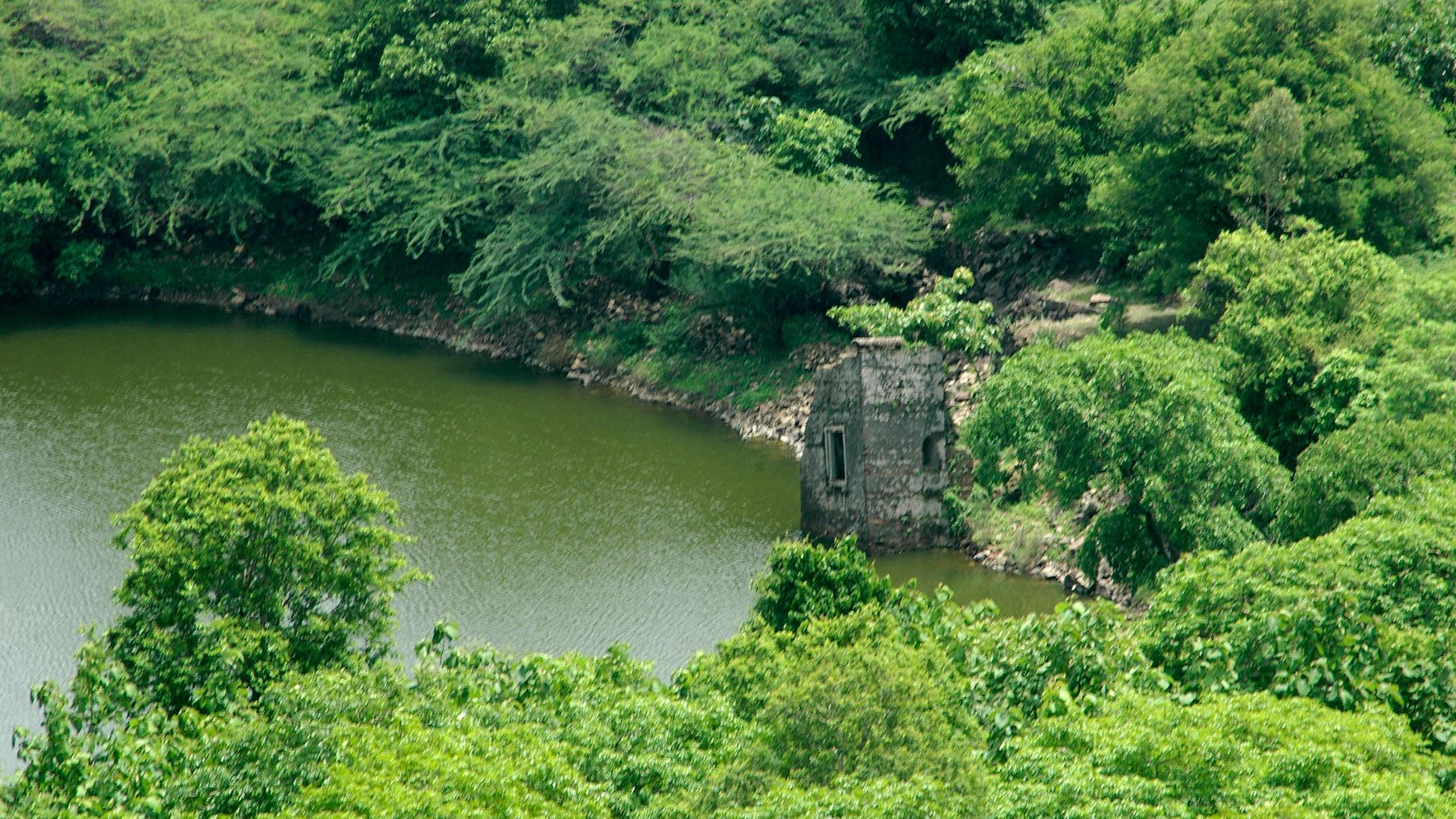A grant from the U.S. Ambassadors Fund for Cultural Preservation is helping to preserve the Medhi Talao Ensemble at Champaner-Pavagadh in Gujarat.
January 2019

Medhi Talao, the large man-made pond at Champaner-Pavagadh revitalized using the the U.S. Ambassador’s Fund for Cultural Preservation grant. (Photograph by Rahul Gajjar)
In the 15th and 16th centuries, the city of Champaner in Gujarat was a critical post along the trade route linking the state with the Malwa region in western India. Medieval Champaner grew and developed at the base of the towering Pavagadh Hill, an 800-meter-high peak upon which a fortress was built in the 10th century. It remains a Hindu pilgrimage site to this day. But, over the hundreds of years since its construction, this historic site got lost beneath dense forest cover.
In 2003, the U.S. Ambassadors Fund for Cultural Preservation (AFCP) provided $20,619 (Rs. 15 lakhs) for the revival of the Medhi Talao Ensemble at Champaner-Pavagadh. This grant enabled the Heritage Trust in Vadodara, which works on conserving the city’s heritage, to begin salvaging Champaner-Pavagadh through preservation and conservation initiatives. Champaner-Pavagadh was designated a UNESCO World Heritage Site in 2004.
Excerpts from an interview with Sandhya Gajjar, a member of Heritage Trust’s managing committee, who was instrumental in the protection of Champaner-Pavagadh.
How did you get involved in the preservation of Champaner-Pavagadh?
I was part of the volunteer core team instituted by the Heritage Trust with a focused target of getting the UNESCO World Heritage Site status for Champaner-Pavagadh. The site had major issues—quarrying being one of them—which were a real threat to the standing architectural heritage along the Pavagadh Hill as well as on the Champaner plain.
At a personal level, my husband, Rahul Gajjar, had been in touch with the [Mumbai] American Center, as it was then known, since the early 1990’s. He had hosted a number of art exhibitions by photographers from all parts of India and the United States in Baroda [now called Vadodara], which were inaugurated by senior officials of the U.S. Embassy. He would always take them to visit Champaner-Pavagadh.
What would you say is the most fascinating feature of the Champaner-Pavagadh site and why?
What I find most fascinating is its dual location—the Pavagadh Hill and the Champaner plain at its foot. At the main entry, the ruins of the fortified Champaner, capital of medieval Gujarat, are separated from the way up the Pavagadh hill by just a strip of road. Most of the 114 heritage monuments, listed by Heritage Trust, are in this area; spread over six square kilometers of the Core Zone of the site. Some of these are among the most amazing examples of stone carving and architecture.

Saat Kaman or Seven Arches, a major tourist attraction at Champaner-Pavagadh. (Photograph by Rahul Gajjar)
What process or strategy was followed by Heritage Trust when planning the preservation of this historical site?
As a nonprofit, our role is focused on activating public awareness and engagement with the site, and providing proactive support to the government agencies involved in the preservation and conservation work.
Our strategy with Champaner-Pavagadh was to initially get it on the World Monuments Fund’s watchlist of 100 Most Endangered Heritage Sites in 2000. Our next step was to apply for the U.S. Ambassadors Fund for Cultural Preservation grant. Since we were aiming to get our dossier ready for the UNESCO World Heritage Site meeting for 2004, we were going full steam ahead documenting every aspect of Champaner-Pavagadh. Some of this work revealed the extraordinary water conservation systems that the Hindu and Jain rulers of Pavagadh had put in place over the many centuries of their rule.
What activities were undertaken using the U.S. Ambassadors Fund for Cultural Preservation grant?
Medhi Talao was a large man-made pond at such a strategic point that it gathered almost all the rainwater flowing down that part of the hill, for use by people during the hot summer months. The talao [pond] had stone steps all around it, which made it easy to access and use for local people and pilgrims. There was also a square structure jutting out, like a tower, on the edge of the pond.
The grant was used for the revitalization of the Medhi Talao complex. The ruined structure around the talao was documented and several of the ruined pieces that had fallen into it were fished out, cleaned and placed in what was “reconstructed” as the talao environs in the time of the Sultans or Rajput rulers at Pavagadh Hill.
Winning the AFCP grant and the subsequent visits to the site by people from the U.S. Embassy created a qualitative boost for the till-then-largely-ignored site. It created a buzz in the state media and a sense of pride among the locals, who had been living in the shadow of the heritage monument for generations.
Jason Chiang is a freelance writer based in Silver Lake, Los Angeles.
COMMENTS